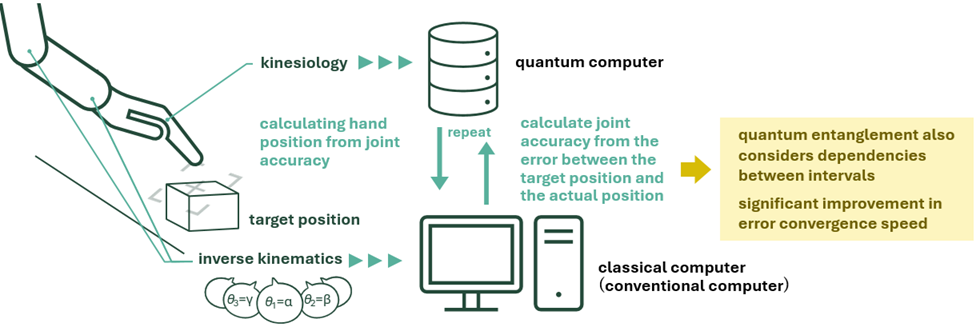PRESS RELEASE
Shibaura Institute of Technology, Waseda University and Fujitsu develop quantum computer-based robot posture optimization
Enabling smoother, more complex movements for next-generation robots
Shibaura Institute of Technology
Waseda University
Fujitsu Limited
Tokyo and Kawasaki, Japan, August 25, 2025
Shibaura Institute of Technology (Associate Professor Takuya Otani, Faculty of System Science and Engineering [Human Robot System Laboratory]), Waseda University (Professor Atsuo Takanishi, Faculty of Science and Engineering), and Fujitsu Limited today announced the development of an innovative method for efficiently controlling robot posture using quantum computing technology. This new approach facilitates the efficient and accurate calculation of inverse kinematics, i.e., determining joint angles from a target end-effector position, for multi-joint robots by leveraging qubit-based position representation and quantum entanglement. Verification using Fujitsu's quantum simulator achieved up to a 43% error reduction with fewer calculations compared to conventional methods. The effectiveness of quantum entanglement was also confirmed through an experiment carried out on the 64-qubit quantum computer jointly developed by RIKEN and Fujitsu.
By expressing the orientation and position of each robot link as a qubit, and by replicating the structural influence of parent joint movements on child joints through quantum entanglement, the number of necessary calculations was significantly reduced compared to conventional classical methods. As quantum computing advances towards practical application, this development is expected to contribute substantially to the creation of next-generation robots that demand real-time control and complex operational capabilities.

Quantum technology breakthrough for complex robot posture calculation
In robot posture control, calculating inverse kinematics is crucial. For robots with multiple joints, the possible angle combinations are numerous, requiring iterative calculations to minimize the discrepancy from the target position and resulting in a high computational load. For a full-body multi-joint model with 17 joints, equivalent to the number of joints in the human body, the number of possible calculations required are too vast to be solved directly. A common approach has been to perform motion calculations with an approximated 7 joints, but this limits the smoothness of movement.
In this research, a new method leveraging the power of quantum computing has been proposed to address these challenges. The orientation and position of each robot part (link) are represented by qubits, and forward kinematics, i.e., calculation of end-effector position from joint angles, is carried out using quantum circuits. Inverse kinematics calculations are performed on classical computers, achieving efficient posture control through a hybrid quantum-classical approach.
Improved convergence speed and accuracy with quantum entanglement
Furthermore, by introducing quantum entanglement, the structure where the movement of parent joints naturally influences child joints is reproduced on the quantum circuit. This significantly improved the convergence speed and accuracy of inverse kinematics calculations. In addition, a trial calculation showed that motion calculations for a full-body multi-joint model with 17 joints can be executed in approximately 30 minutes.
Expected applications in humanoid and multi-joint robots
This method can express the posture of multi-joint robots with a small number of qubits, making it implementable even in current noise intermediate-scale quantum (NISQ) computers. In the future, this technology could be applied to real-time control of humanoid robots and multi-joint manipulators, obstacle avoidance, and energy optimization. Further performance improvements are also anticipated through combination with advanced quantum algorithms such as quantum Fourier transform.
Research paper details
Authors:
・Takuya Otani, Shibaura Institute of Technology, Faculty of System Science and Engineering
・Atsuo Takanishi, Waseda University, Faculty of Science and Engineering
・Nobuyuki Hara, Fujitsu Limited
・Yutaka Takita, Fujitsu Limited
・Koichi Kimura, Fujitsu Limited
Title: Quantum computation for robot posture optimization
Press Contacts
Shibaura Institute of Technology
Admissions and Public Relations Department, Planning and Public Relations Division, Tateiwa
TEL: 03-5859-7070 FAX: 03-5859-7071
Waseda University
Office of Information and Public Relations
Matsuki
TEL: 03-3202-5454
Fujitsu Limited
Public and Investor Relations Division
All company or product names mentioned herein are trademarks or registered trademarks of their respective owners. Information provided in this press release is accurate at time of publication and is subject to change without advance notice.
Date: 25 August, 2025
City: Tokyo and Kawasaki, Japan
Company: Shibaura Institute of Technology, Waseda University, Fujitsu Limited
